Negligence Liability of MacTools Ltd
VerifiedAdded on 2020/03/02
|6
|1280
|33
AI Summary
This business law assignment analyzes the negligence liability of manufacturer MacTools Ltd. A power drill manufactured by them explodes, resulting in Aurora losing an eye and Jessie's glass vase shattering. The case explores duty of care, breach of duty, causation, and damages, considering factors like product warnings, user negligence, and the 'egg shell rule'. The assignment concludes on MacTools Ltd.'s potential liability and the impact of contributory negligence.
Contribute Materials
Your contribution can guide someone’s learning journey. Share your
documents today.
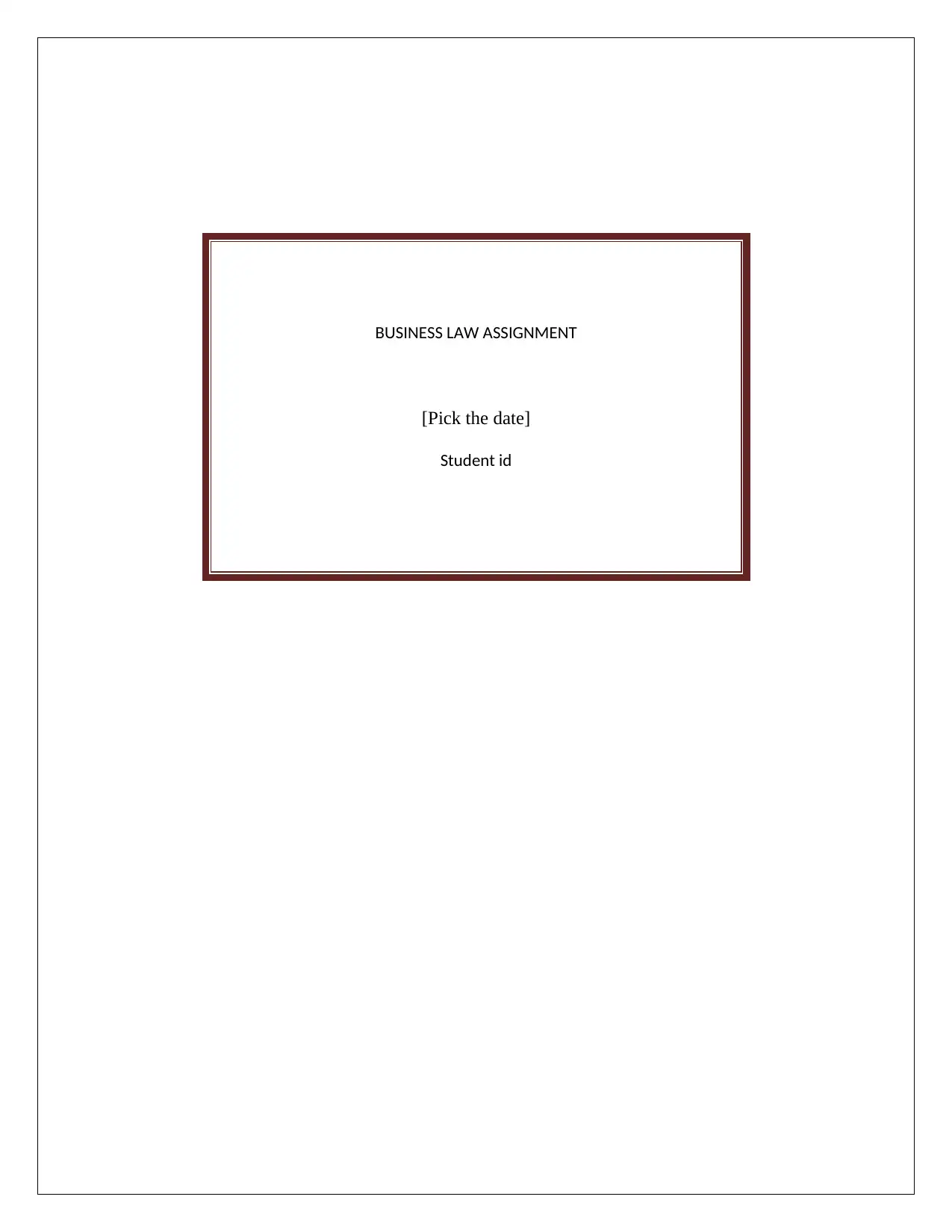
BUSINESS LAW ASSIGNMENT
[Pick the date]
Student id
[Pick the date]
Student id
Secure Best Marks with AI Grader
Need help grading? Try our AI Grader for instant feedback on your assignments.
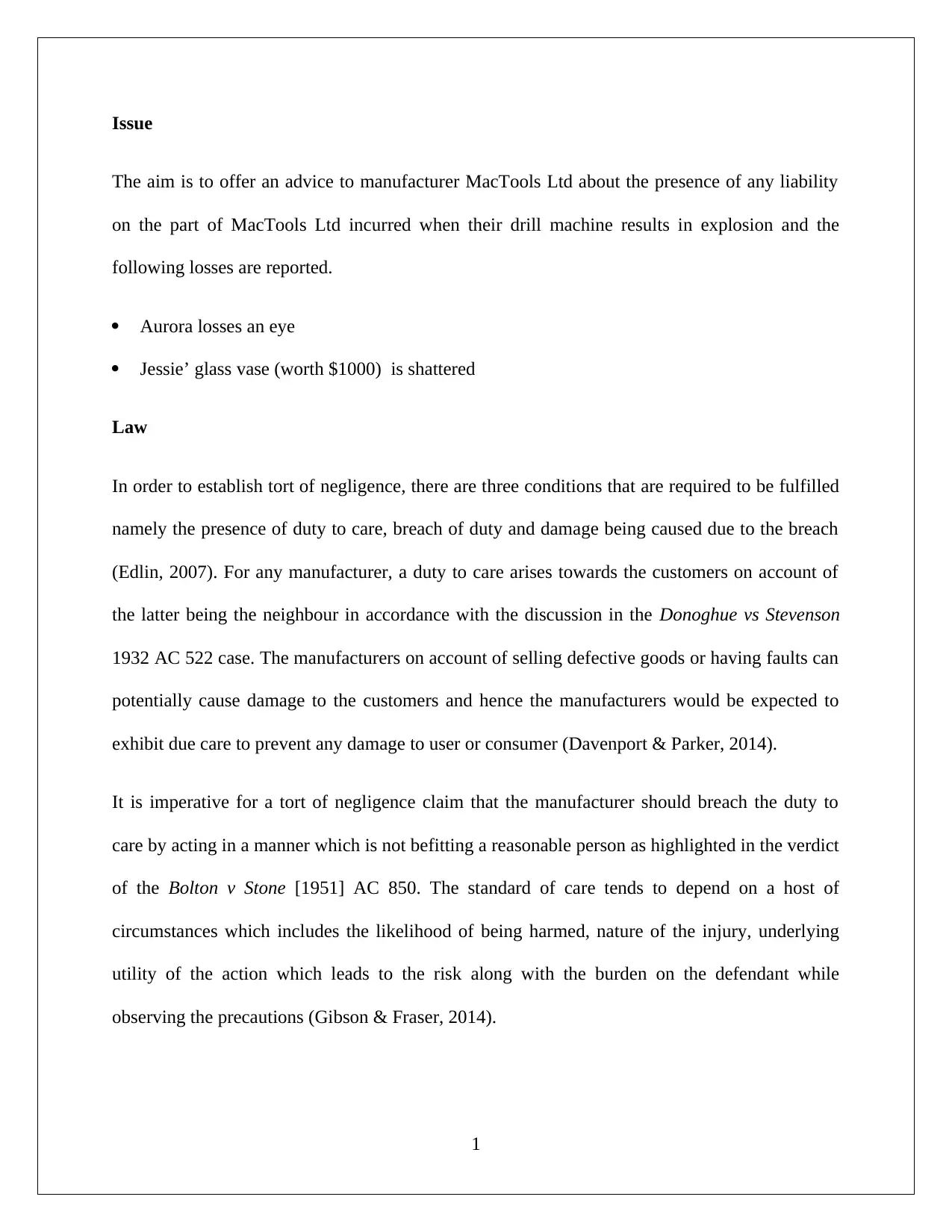
Issue
The aim is to offer an advice to manufacturer MacTools Ltd about the presence of any liability
on the part of MacTools Ltd incurred when their drill machine results in explosion and the
following losses are reported.
Aurora losses an eye
Jessie’ glass vase (worth $1000) is shattered
Law
In order to establish tort of negligence, there are three conditions that are required to be fulfilled
namely the presence of duty to care, breach of duty and damage being caused due to the breach
(Edlin, 2007). For any manufacturer, a duty to care arises towards the customers on account of
the latter being the neighbour in accordance with the discussion in the Donoghue vs Stevenson
1932 AC 522 case. The manufacturers on account of selling defective goods or having faults can
potentially cause damage to the customers and hence the manufacturers would be expected to
exhibit due care to prevent any damage to user or consumer (Davenport & Parker, 2014).
It is imperative for a tort of negligence claim that the manufacturer should breach the duty to
care by acting in a manner which is not befitting a reasonable person as highlighted in the verdict
of the Bolton v Stone [1951] AC 850. The standard of care tends to depend on a host of
circumstances which includes the likelihood of being harmed, nature of the injury, underlying
utility of the action which leads to the risk along with the burden on the defendant while
observing the precautions (Gibson & Fraser, 2014).
1
The aim is to offer an advice to manufacturer MacTools Ltd about the presence of any liability
on the part of MacTools Ltd incurred when their drill machine results in explosion and the
following losses are reported.
Aurora losses an eye
Jessie’ glass vase (worth $1000) is shattered
Law
In order to establish tort of negligence, there are three conditions that are required to be fulfilled
namely the presence of duty to care, breach of duty and damage being caused due to the breach
(Edlin, 2007). For any manufacturer, a duty to care arises towards the customers on account of
the latter being the neighbour in accordance with the discussion in the Donoghue vs Stevenson
1932 AC 522 case. The manufacturers on account of selling defective goods or having faults can
potentially cause damage to the customers and hence the manufacturers would be expected to
exhibit due care to prevent any damage to user or consumer (Davenport & Parker, 2014).
It is imperative for a tort of negligence claim that the manufacturer should breach the duty to
care by acting in a manner which is not befitting a reasonable person as highlighted in the verdict
of the Bolton v Stone [1951] AC 850. The standard of care tends to depend on a host of
circumstances which includes the likelihood of being harmed, nature of the injury, underlying
utility of the action which leads to the risk along with the burden on the defendant while
observing the precautions (Gibson & Fraser, 2014).
1
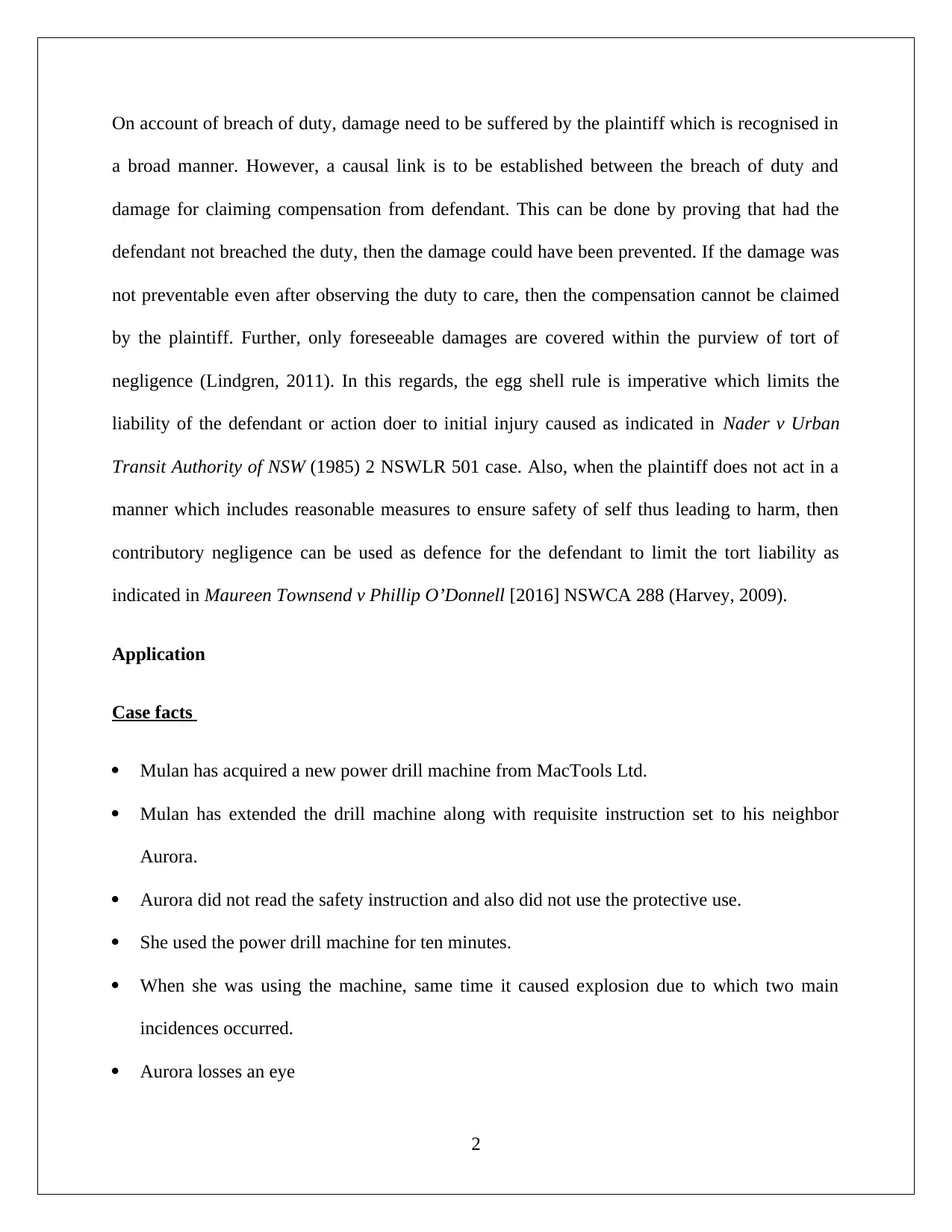
On account of breach of duty, damage need to be suffered by the plaintiff which is recognised in
a broad manner. However, a causal link is to be established between the breach of duty and
damage for claiming compensation from defendant. This can be done by proving that had the
defendant not breached the duty, then the damage could have been prevented. If the damage was
not preventable even after observing the duty to care, then the compensation cannot be claimed
by the plaintiff. Further, only foreseeable damages are covered within the purview of tort of
negligence (Lindgren, 2011). In this regards, the egg shell rule is imperative which limits the
liability of the defendant or action doer to initial injury caused as indicated in Nader v Urban
Transit Authority of NSW (1985) 2 NSWLR 501 case. Also, when the plaintiff does not act in a
manner which includes reasonable measures to ensure safety of self thus leading to harm, then
contributory negligence can be used as defence for the defendant to limit the tort liability as
indicated in Maureen Townsend v Phillip O’Donnell [2016] NSWCA 288 (Harvey, 2009).
Application
Case facts
Mulan has acquired a new power drill machine from MacTools Ltd.
Mulan has extended the drill machine along with requisite instruction set to his neighbor
Aurora.
Aurora did not read the safety instruction and also did not use the protective use.
She used the power drill machine for ten minutes.
When she was using the machine, same time it caused explosion due to which two main
incidences occurred.
Aurora losses an eye
2
a broad manner. However, a causal link is to be established between the breach of duty and
damage for claiming compensation from defendant. This can be done by proving that had the
defendant not breached the duty, then the damage could have been prevented. If the damage was
not preventable even after observing the duty to care, then the compensation cannot be claimed
by the plaintiff. Further, only foreseeable damages are covered within the purview of tort of
negligence (Lindgren, 2011). In this regards, the egg shell rule is imperative which limits the
liability of the defendant or action doer to initial injury caused as indicated in Nader v Urban
Transit Authority of NSW (1985) 2 NSWLR 501 case. Also, when the plaintiff does not act in a
manner which includes reasonable measures to ensure safety of self thus leading to harm, then
contributory negligence can be used as defence for the defendant to limit the tort liability as
indicated in Maureen Townsend v Phillip O’Donnell [2016] NSWCA 288 (Harvey, 2009).
Application
Case facts
Mulan has acquired a new power drill machine from MacTools Ltd.
Mulan has extended the drill machine along with requisite instruction set to his neighbor
Aurora.
Aurora did not read the safety instruction and also did not use the protective use.
She used the power drill machine for ten minutes.
When she was using the machine, same time it caused explosion due to which two main
incidences occurred.
Aurora losses an eye
2
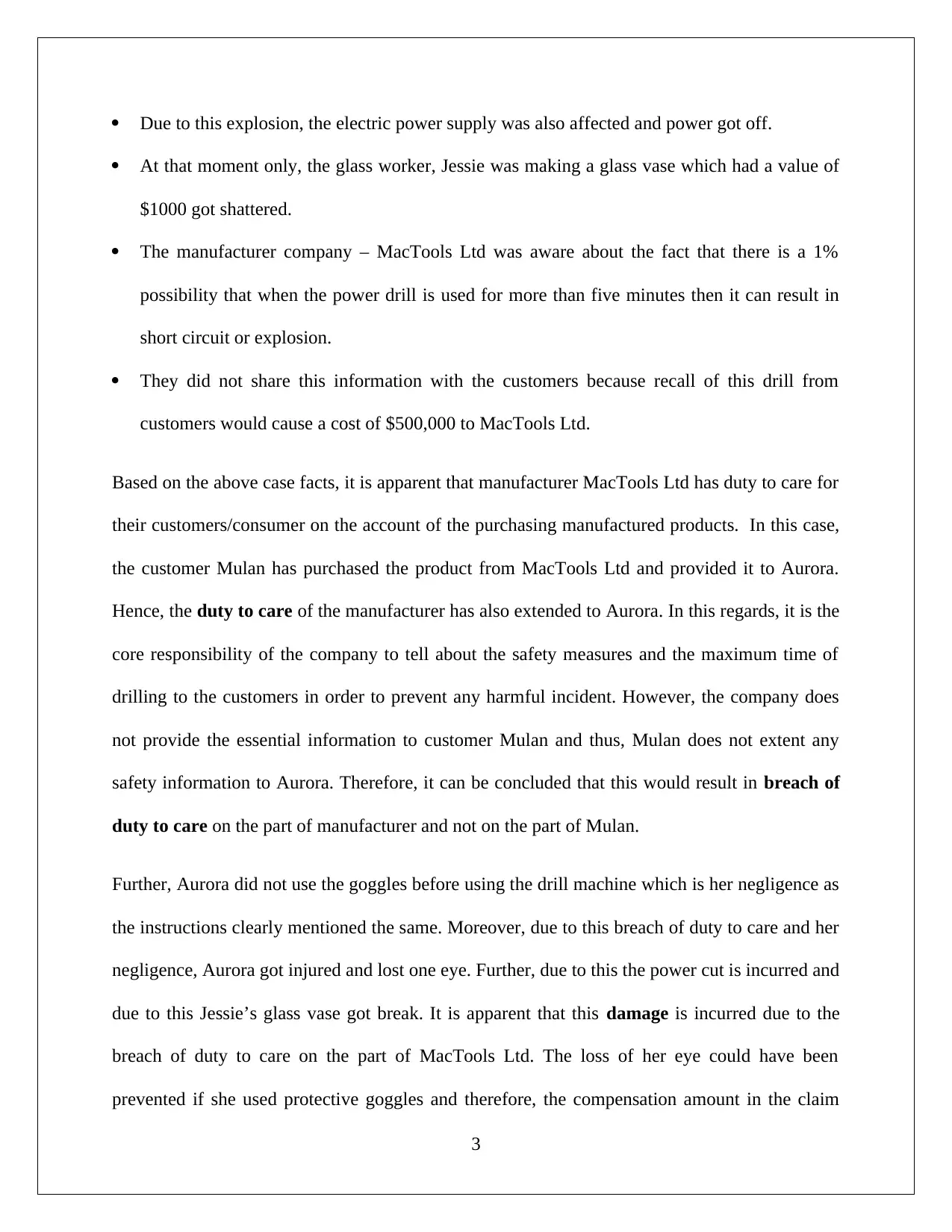
Due to this explosion, the electric power supply was also affected and power got off.
At that moment only, the glass worker, Jessie was making a glass vase which had a value of
$1000 got shattered.
The manufacturer company – MacTools Ltd was aware about the fact that there is a 1%
possibility that when the power drill is used for more than five minutes then it can result in
short circuit or explosion.
They did not share this information with the customers because recall of this drill from
customers would cause a cost of $500,000 to MacTools Ltd.
Based on the above case facts, it is apparent that manufacturer MacTools Ltd has duty to care for
their customers/consumer on the account of the purchasing manufactured products. In this case,
the customer Mulan has purchased the product from MacTools Ltd and provided it to Aurora.
Hence, the duty to care of the manufacturer has also extended to Aurora. In this regards, it is the
core responsibility of the company to tell about the safety measures and the maximum time of
drilling to the customers in order to prevent any harmful incident. However, the company does
not provide the essential information to customer Mulan and thus, Mulan does not extent any
safety information to Aurora. Therefore, it can be concluded that this would result in breach of
duty to care on the part of manufacturer and not on the part of Mulan.
Further, Aurora did not use the goggles before using the drill machine which is her negligence as
the instructions clearly mentioned the same. Moreover, due to this breach of duty to care and her
negligence, Aurora got injured and lost one eye. Further, due to this the power cut is incurred and
due to this Jessie’s glass vase got break. It is apparent that this damage is incurred due to the
breach of duty to care on the part of MacTools Ltd. The loss of her eye could have been
prevented if she used protective goggles and therefore, the compensation amount in the claim
3
At that moment only, the glass worker, Jessie was making a glass vase which had a value of
$1000 got shattered.
The manufacturer company – MacTools Ltd was aware about the fact that there is a 1%
possibility that when the power drill is used for more than five minutes then it can result in
short circuit or explosion.
They did not share this information with the customers because recall of this drill from
customers would cause a cost of $500,000 to MacTools Ltd.
Based on the above case facts, it is apparent that manufacturer MacTools Ltd has duty to care for
their customers/consumer on the account of the purchasing manufactured products. In this case,
the customer Mulan has purchased the product from MacTools Ltd and provided it to Aurora.
Hence, the duty to care of the manufacturer has also extended to Aurora. In this regards, it is the
core responsibility of the company to tell about the safety measures and the maximum time of
drilling to the customers in order to prevent any harmful incident. However, the company does
not provide the essential information to customer Mulan and thus, Mulan does not extent any
safety information to Aurora. Therefore, it can be concluded that this would result in breach of
duty to care on the part of manufacturer and not on the part of Mulan.
Further, Aurora did not use the goggles before using the drill machine which is her negligence as
the instructions clearly mentioned the same. Moreover, due to this breach of duty to care and her
negligence, Aurora got injured and lost one eye. Further, due to this the power cut is incurred and
due to this Jessie’s glass vase got break. It is apparent that this damage is incurred due to the
breach of duty to care on the part of MacTools Ltd. The loss of her eye could have been
prevented if she used protective goggles and therefore, the compensation amount in the claim
3
Secure Best Marks with AI Grader
Need help grading? Try our AI Grader for instant feedback on your assignments.
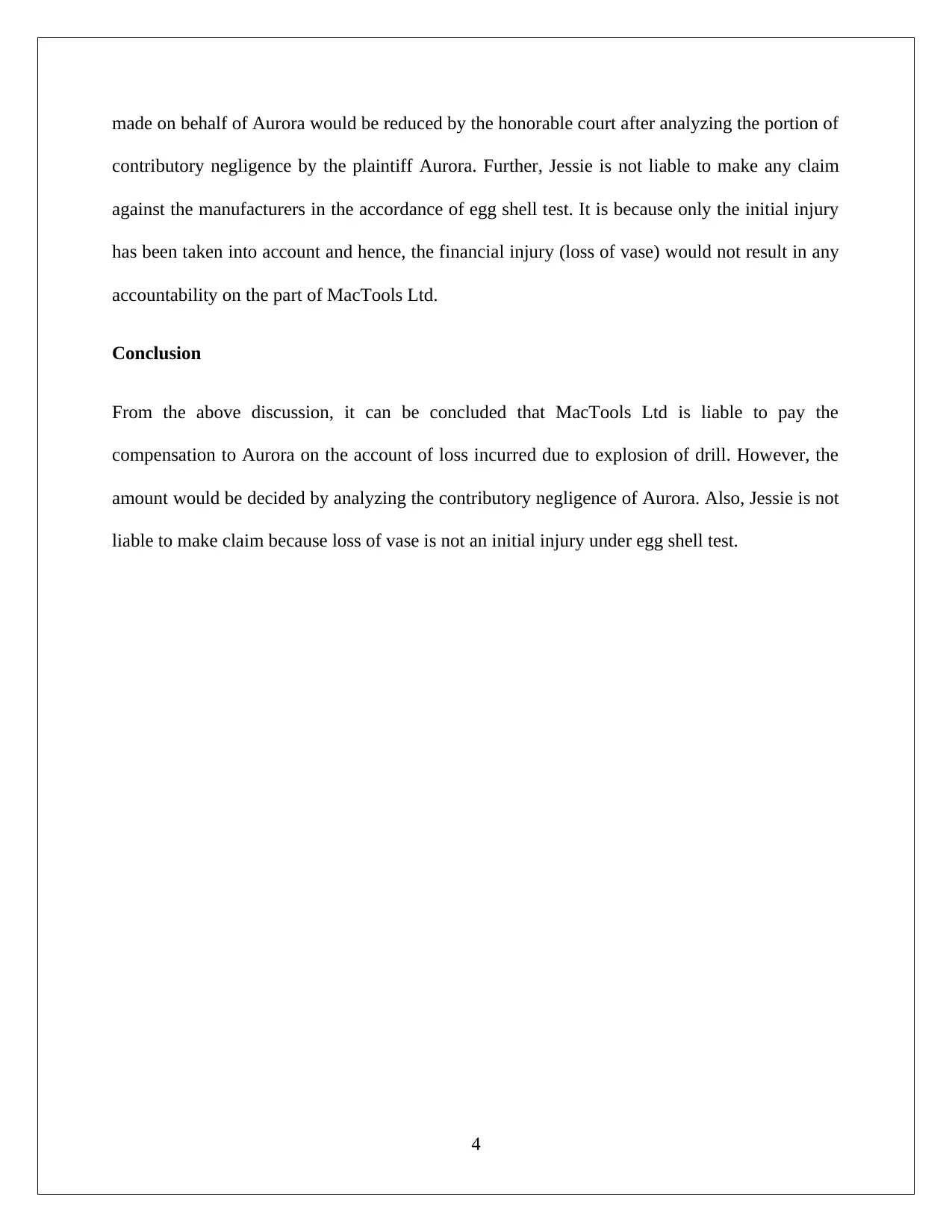
made on behalf of Aurora would be reduced by the honorable court after analyzing the portion of
contributory negligence by the plaintiff Aurora. Further, Jessie is not liable to make any claim
against the manufacturers in the accordance of egg shell test. It is because only the initial injury
has been taken into account and hence, the financial injury (loss of vase) would not result in any
accountability on the part of MacTools Ltd.
Conclusion
From the above discussion, it can be concluded that MacTools Ltd is liable to pay the
compensation to Aurora on the account of loss incurred due to explosion of drill. However, the
amount would be decided by analyzing the contributory negligence of Aurora. Also, Jessie is not
liable to make claim because loss of vase is not an initial injury under egg shell test.
4
contributory negligence by the plaintiff Aurora. Further, Jessie is not liable to make any claim
against the manufacturers in the accordance of egg shell test. It is because only the initial injury
has been taken into account and hence, the financial injury (loss of vase) would not result in any
accountability on the part of MacTools Ltd.
Conclusion
From the above discussion, it can be concluded that MacTools Ltd is liable to pay the
compensation to Aurora on the account of loss incurred due to explosion of drill. However, the
amount would be decided by analyzing the contributory negligence of Aurora. Also, Jessie is not
liable to make claim because loss of vase is not an initial injury under egg shell test.
4
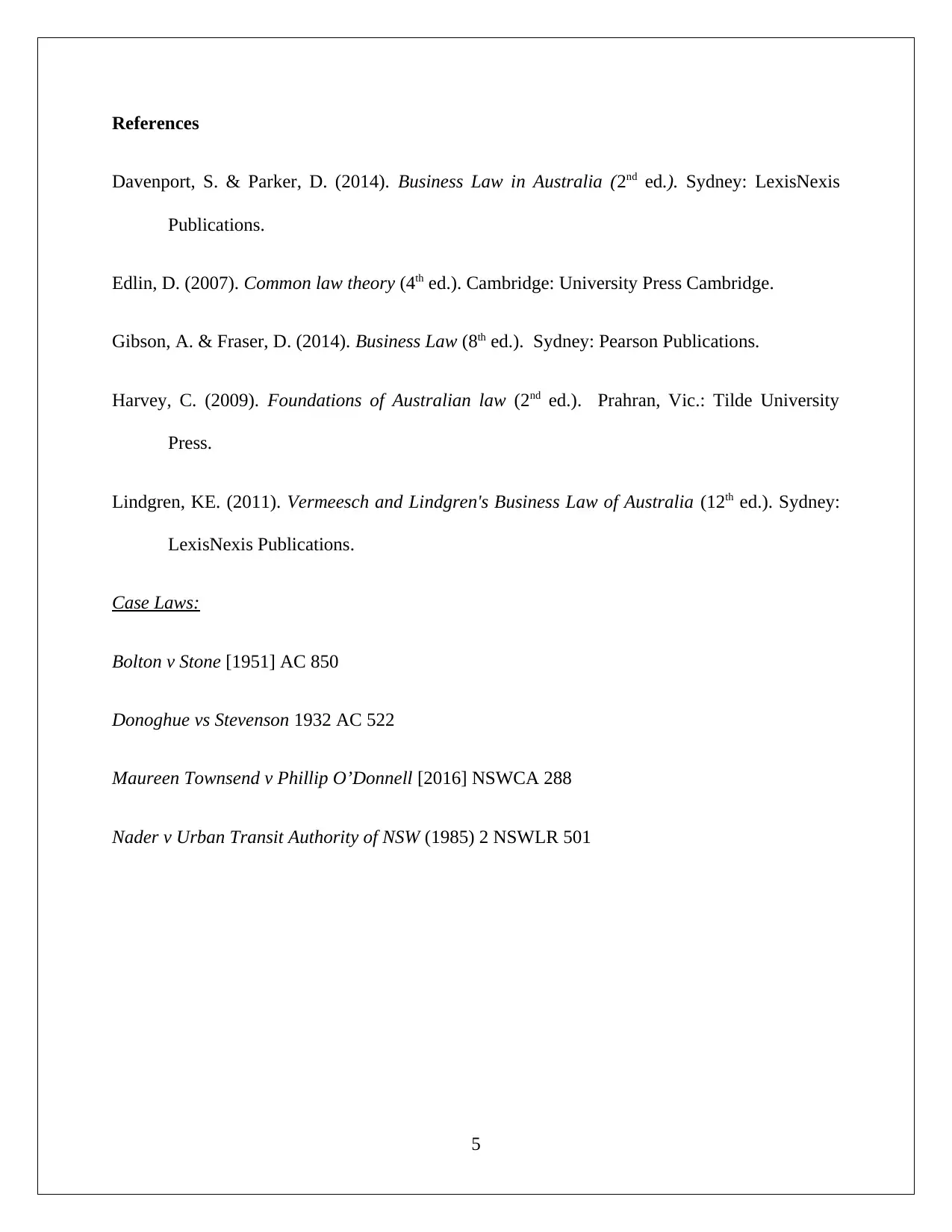
References
Davenport, S. & Parker, D. (2014). Business Law in Australia (2nd ed.). Sydney: LexisNexis
Publications.
Edlin, D. (2007). Common law theory (4th ed.). Cambridge: University Press Cambridge.
Gibson, A. & Fraser, D. (2014). Business Law (8th ed.). Sydney: Pearson Publications.
Harvey, C. (2009). Foundations of Australian law (2nd ed.). Prahran, Vic.: Tilde University
Press.
Lindgren, KE. (2011). Vermeesch and Lindgren's Business Law of Australia (12th ed.). Sydney:
LexisNexis Publications.
Case Laws:
Bolton v Stone [1951] AC 850
Donoghue vs Stevenson 1932 AC 522
Maureen Townsend v Phillip O’Donnell [2016] NSWCA 288
Nader v Urban Transit Authority of NSW (1985) 2 NSWLR 501
5
Davenport, S. & Parker, D. (2014). Business Law in Australia (2nd ed.). Sydney: LexisNexis
Publications.
Edlin, D. (2007). Common law theory (4th ed.). Cambridge: University Press Cambridge.
Gibson, A. & Fraser, D. (2014). Business Law (8th ed.). Sydney: Pearson Publications.
Harvey, C. (2009). Foundations of Australian law (2nd ed.). Prahran, Vic.: Tilde University
Press.
Lindgren, KE. (2011). Vermeesch and Lindgren's Business Law of Australia (12th ed.). Sydney:
LexisNexis Publications.
Case Laws:
Bolton v Stone [1951] AC 850
Donoghue vs Stevenson 1932 AC 522
Maureen Townsend v Phillip O’Donnell [2016] NSWCA 288
Nader v Urban Transit Authority of NSW (1985) 2 NSWLR 501
5
1 out of 6
Related Documents
Your All-in-One AI-Powered Toolkit for Academic Success.
+13062052269
info@desklib.com
Available 24*7 on WhatsApp / Email
![[object Object]](/_next/static/media/star-bottom.7253800d.svg)
Unlock your academic potential
© 2024 | Zucol Services PVT LTD | All rights reserved.





